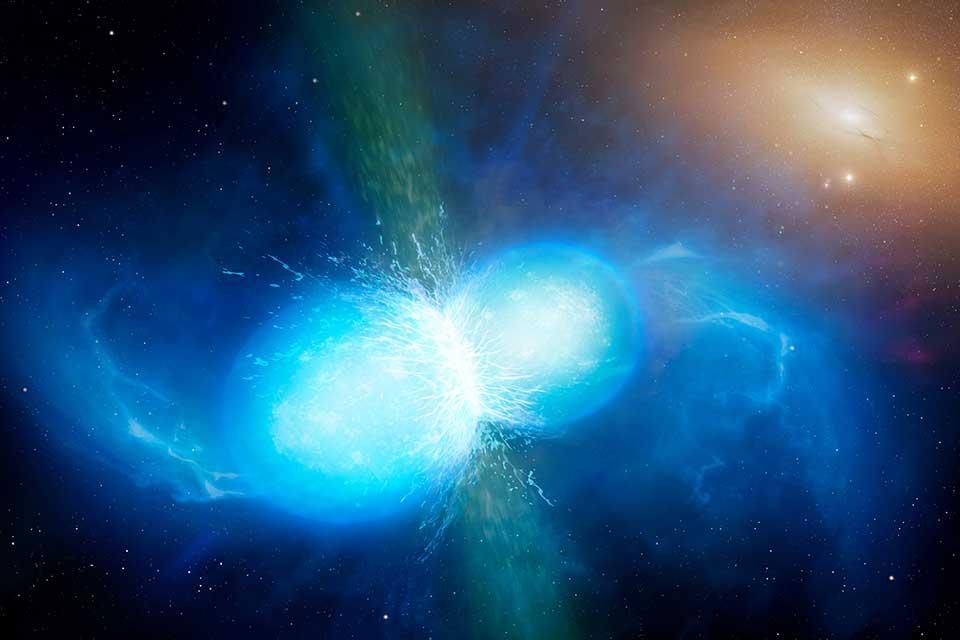Researchers from the University of Oxford's Department of Physics have contributed to an international effort to identify the neutron star merger responsible for an exceptionally bright gamma-ray burst. The study also detected the chemical element tellurium, providing new evidence that neutron star mergers can generate rare, heavy elements. The findings have been published in the journal Nature.
Neutron stars form when massive stars run out of fuel and collapse in on themselves, and are the densest object astronomers can observe directly. When a neutron star merges with either a black hole or with another neutron star, it produces an explosion called a kilonova.
It has long been theorised that neutron star mergers would be ideal 'pressure cookers' to create some of the rarer elements substantially heavier than iron. To date, there has been little evidence for this since kilonovae are extremely rare events and difficult to observe directly. However short gamma-ray bursts can be by-products of these infrequent merger episodes, enabling their presence to be inferred.
In March 2023, NASA’s Fermi Gamma-ray Space Telescope detected the second brightest gamma-ray burst observed in over 50 years of observations – about 1,000 times brighter than a typical gamma ray burst.
After the first detection, an intensive series of observations from space and ground-based telescopes swung into action to pinpoint the source on the sky and track how its brightness changed. These observations in the gamma-ray, X-ray, optical, infrared, and radio showed that the optical/infrared counterpart was faint, evolved quickly, and transitioned from blue to red – the hallmarks of a kilonova.
JWST: unprecedented detail
Kilonovae explosions evolve rapidly, with the cloud of material expanding swiftly. As the material cools, the peak of its light becomes visible in the infrared, then moves even further redward on timescales of days to weeks. Until now, it has been impossible to study these later timepoints from ground-based telescopes. Most infrared light does not penetrate the Earth’s atmosphere and the sky is very bright at these wavelengths. However, the James Webb Space Telescope’s NIRCam (Near-Infrared Camera) and NIRSpec (Near-Infrared Spectrograph) instruments were designed to be very sensitive to heat radiation and were able to observe these stages in unprecedented detail.
Professor of Astrophysics Stephen Smartt , from the University of Oxford’s Department of Physics, helped to confirm the newly-observed kilonova by comparing the infrared emission spectra to that of a previously-observed kilonova, originally detected by gravitational wave experiments.
He said: ‘The data showed a strong excess of infrared emission – around 2.2 microns – very similar to that observed in the kilonova that was produced with the gravitational wave source GW170817. The similarity of the spectra and the quick fade convinced us the kilonova explanation is the most likely.’
Dr Lauren Rhodes also from Oxford's Department of Physics helped to contextualise the kilonova using radio wave data from the MeerKAT radio telescope in South Africa: ‘Interestingly, the radio counterparts of the gamma-ray bursts produced by these binary neutron star mergers have an unexpectedly low luminosity. It is clear that we need to discover more of these events to fully understand the global picture of these most energetic explosions.’
The spectrum recorded by Webb also clearly showed light emitted by tellurium, an element rarer than platinum and gold in the Earth's crust, but predicted by nuclear physics to be produced in neutron star mergers. The highly sensitive infrared capabilities of Webb also helped scientists identify the home address of the two neutron stars that created the kilonova: a spiral galaxy about 120,000 light-years away from the site of the merger. The progenitor stars were once two normal massive stars that formed a binary system in their home galaxy, then travelled approximately the equivalent of the Milky Way galaxy’s diameter before merging several hundred million years later.
Dr Heloise Stevance from Oxford's Department of Physics, used data from the MUSE instrument on the Very Large Telescope to determine the age and metal content of the progenitor stars’ home galaxy. She said: ‘As we discover more neutron star mergers, we will be able to paint a more refined picture of what their progenitor stars looked like and what their life story must have been. When we do find the next kilonova from a burst of gravitational waves, things are going to be really interesting because now Webb is in space, it will be able to take splendid images and spectra of the home galaxy in wavelengths not accessible from the ground.’
Professor Smartt concluded: ‘The sensitivity of the James Webb Space Telescope has been a game changer in studying events such as these in the infrared. This enables us to detect phenomena that would be impossible to observe using ground-based telescopes. This study has set a precedent for detecting neutron star mergers using gamma-ray bursts, and the next stage is to find more of these events, and determine if they are primarily responsible for the existence of the elements heavier than iron.’
Heavy element production in a compact object merger observed by JWST, A Levan et al, Nature, 2023

